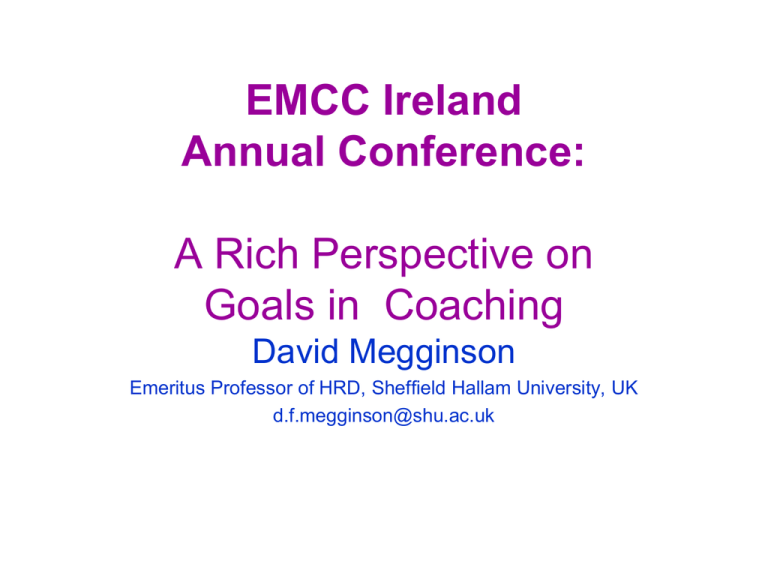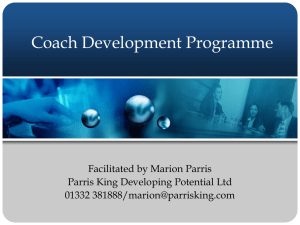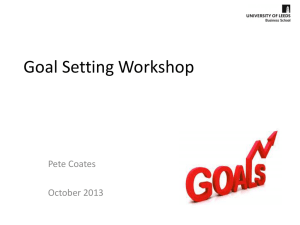Prof._Megginson_EMCC_Conf_2012
advertisement

EMCC Ireland Annual Conference: A Rich Perspective on Goals in Coaching David Megginson Emeritus Professor of HRD, Sheffield Hallam University, UK d.f.megginson@shu.ac.uk Goals are pervasive in Western culture Plato said (in The Republic) ‘What goals must we pursue in order to be as happy as we can be?’ … and he didn’t seem to wonder about what life would be like without goals Sequence of goal setting • When do you set goals? • 1 of 4: Whitmore (2002) best set at the start. • 3 of 6: Grant (2011) emphasises self-regulation and has developed a model, REGROW, where goals are only set after stages of Review and Evaluation. • 4 of 7: Kilburg (2000) places goals as the fourth of a sevenstage approach, which he describes as a fluid process, explaining that “sometimes the shift [to goals] is not clear and we just progressively deepen the discussion about a particular topic” (p. 82). • 5 of 9: Egan’s (2008) skilled helper model have goals or the change agenda as the fifth stage of a nine-stage process (Connor and Pokora, 2007). • 5 of 7: Pemberton (2006) saves goals (or Targeting as she calls it) for the fifth of her seven stage STARTED model. • 5 of 5: Peseschkian’s Positive Psychotherapy (PPT), with its focus on the patient’s strengths and capacity to help themself (Peseschkian & Tritt, 1998) involves five stages, with goals being the last. In this final stage, the patient is asked, “What would you like to do, when no more problems are left to solve?” (Peseschkian & Tritt, 1998, p. 98). Grant’s (2007) goal dimensions • • • • Proximal (close) Concrete Approach Performance or Distal (distant) or Abstract or Avoidance or Learning So, what kind of goals do you set? Grant, A.M. (2007). When own goals are a winner. Coaching at Work, 2(2), 32-35. Themes in goal pursuit Which of these themes matters most to you? (Extracted from 10 contemporary texts on coaching) 1. Clientcenteredness 2. Alignment 3. Ownership 4. Personal meaning 5. Holism 6. Clarity 7. Control 8. Positivity 9. Challenge 10.Prioritization 11.Action 12.Relationship 13.Completion Factors influencing progress towards goals in our own practice • Motivation (How important is it to you?) • Contextual awareness (How accurate is your picture of external factors that may help or hinder achievement?) • Ownership (Who shares this goal and has a stake in its outcome?) • Clarity (Are you able to envision the outcome?) • Measurability (Will you be able to assess the outcome?) • Stability (Is it a fixed or moving target?) • Link to personal values (Is it aligned with an inner “sense of rightness”?) • Previous experience of goal pursuit (Have you had success with goal setting in the past?) Ordóñez et al. Critique • The problem of specificity • The risks of challenge • The drawbacks of competitive performance • Threats to motivation • How do you counteract the dangers? • Ordóñez, L.D., Schweitzer, M.E., Galinsky, A.E., Bazerman, M.H. (2009). Goals gone wild: The systemic side effects of overprescribing goal setting, Academy of Management Perspectives, February,6-16 Ordóñez et al. Ten questions to assess goals • 1. Are the goals too specific? • 2. Are the goals too challenging? (Especially, are the penalties for failure high?) • 3. Who sets the goals? (How engaged is the goal holder? Who owns them?) • 4. Is the time horizon appropriate? • 5. How might goals influence risk taking? (What does an acceptable level of risk look like?) • 6. How might goals motivate unethical behaviour? • 7. Can goals be idiosyncratically tailored for individual abilities and circumstances while preserving fairness? • 8. How will goals influence organisational culture? (Would team goals be more effective than individual goals?) • 9. Does the goal tap into intrinsic motivation? • 10. What type of goal (performance or learning) is most appropriate in this context? Qualitative study – disadvantages of goals Which of these downsides of goals matter to you and why? From Susan David, David Clutterbuck & David Megginson. 2013. Beyond goals. Aldershot, Gower. 1. 2. 3. 4. 5. 6. 7. 8. 9. 10. Reductionism Narrowing focus Superficial issues Loss of present moment awareness Unconsidered routine Protecting the coach Emergent nature of goals Overloaded with goals Undue pressure from goals Conflict in who sets goals Coaching Goal Orientation Questionnaire* Item Question 1 I set goals with my coachees at the start of a coaching assignment. 2 At the start of a coaching assignment we set goals for the whole assignment. 3 In subsequent coaching sessions we refer back to the goals set at the start. 4 We determine when to finish a coaching assignment by checking whether goals have been achieved. 5 The goals help us to decide whether the coaching is appropriately focused. 6 Goals remain the same throughout the coaching assignment. 7 We set goals for each coaching session. 8 The goals are central to deciding the effectiveness of the coaching. 9 We have purposeful conversations without setting goals. (Reverse scored) *Cronbach’s alpha = .819 Average Goal Orientation Scores by Region* *t(185) = 4.856, p<.001 Goal orientation by region • Why are US coaches more goal oriented than European ones? 1. US coaches are more knowledgeable than Europeans 2. Goals are a feature of US culture more than European culture 3. US coaches are more experienced than European ones Average Goal Orientation Scores by Education *F(2) = 4.118, p = 0.18 Effect of education on goal setting • Why does coach education make coaches more goal oriented 1. Long courses socialise coaches into goal setting; tutors are carriers of the coaching meme 2. Goal setting is good practice and coaches learn how it helps 3. Education helps coaches to be aware of and to name what they are doing Average Goal Orientation scores by Experience and by Region *US: (r(141) = -.008, p=.923) Euro: (r(35) = -.432, p=.010) US and European differences • Why do European coaches become less goal oriented with experience of coaching, while US ones don’t? 1. Goals are more deeply embedded in US than in Europe 2. Coaching is a newer profession in Europe than in US and Europe will resemble US more with experience 3. Europeans recognise the dark side of goals, and become wise in using them less Mean Goal Orientation scores according to “Surprise” responses *F(4) = 4.174, p= .003 Surprise • How do you account for the relationship between surprise and goal orientation? 1. Setting goals makes you rigid and more susceptible to (uncomfortable) surprise 2. Setting goals is creative and generates more (engaging) surprises in the relationship 3. Setting goals prevents the evolution of new kinds of (developmental) question from emerging







